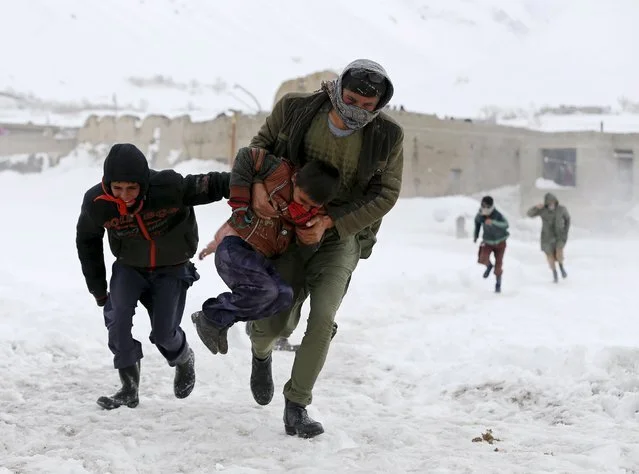Mount Sinabung Erupts… Again
Gunung Sinabung Meletus Lagi
When I saw on the NTD News ticker that Mount Sinabung in Indonesia had erupted, I immediately scrapped the work I was doing on a GMO article. Spoiler alert, GMO’s are the only reason you can afford food, so stfu and eat your meat.
After investigating a bit further into Mount Sinabung, I maybe should have stuck to dispelling the idiotic myths surrounding genetically modified foods, because then I could have used pictures from “Attack of the Killer Tomatoes’. “But Rocky!", you say, “Volcanoes are way cooler!”. Touche. Unfortunately, this is not news worthy.
On Februrary 2, 2021, Mount Sinabung erupted between 1 and “multiple” times. I didn’t get very far because I had to stop caring. I didn’t even bother to find out if there was any property damage or loss of life. In fact, I hope there was. Not because I hate Indonesia, but because I hate stupid people. Indonesia has real problems, like the Parrot Biting Epidemic.
On January 6, 2014 the IB Times reported that Mt. Sinabung had erupted 77 times over the previous weekend. This displaced an estimated 20,000 Indonesians, as well as their parrots (I assume). I don’t know if it has ever erupted before that. Probably, but for the sake of argument, let’s just say that 06/01/2014 was the first time that Sinabung has ever erupted. I’m not against taking chances or even living near supposedly active volcanoes. Mt. St. Helens, for example, wasn’t a giant surprise, but it’s also not repeatedly erupting. In fact, odds are, Mt. St Helens will not erupt again in anyone’s lifetime.
Mt. Sinabung, on the other hand, is obviously an extremely active volcano. After 2014, if anyone is still living near the volcano, they are assuming the risk and have forfeit any sympathy or compassion they might otherwise be owed during a natural disaster. It’s like the people of Pompeii refusing to relocate, even knowing how active the volcano was.
“But Rocky!”, you say, “Don’t be ridiculous! People can’t just get up and move willy-nilly!”. Fair point. Then again, is relocation of your home really more of a risk to your life than living next to a magma fountain?
Alright so now that we’ve properly dismissed anyone that may have suffered as a result of the Sinabung eruption today, let’s check out some stats!
Gunung Sinabung adalah pemandangan yang indah, tapi mematikan! Selalu kagumi dari jarak yang aman!
Of course the first set of stats on Wikipedia is the listing of recent eruptions. Interestingly, it didn’t start erupting until 2010. Given that information, it’s pretty reasonable to assume people would still be living there in 2014.
Letusan Gunung Sinabung (menurut Wikipedia)
August, 2010
3, September, 2010 4:45 AM
3, September 2010 6:00 PM
7, September, 2010
Sekitar 27.489 orang mengalami dislokasi sebagai akibat dari letusan 2010.
15, September, 2013 3:00 AM
5, November, 2013
11, November, 2013 (pyroclastic flow, marks the start of daily ash explosions)
28, December, 2013 (lava dome formed on summit)
4, January, 2014 to 5, January, 2015 >100 Eruptions
1, February, 2014 (2km ash spire, 16 dead)
5, October, 2014 (4 eruptions, 2 km ash spire, 4.5km of pyroclastic flow)
6, October, 2014 to 10 October, 2014 Multiple Eruptions
20, October, 2014 to 25 October, 2014 Multiple Eruptions
26, October, 2014 (3.5km pyroclastic flow, causes avalanches)
22, May, 2016 (7 dead, ash plumes continue throughout 2016)
April, 2017 (Increased activity persisting to present-day)
2, August, 2017 (Plumes observed for the months following)
December, 2017 (Week-long eruption at month’s end, continuing into 2018)
19, February, 2018 (No damage to humans)
6, April, 2018
7, May, 2019 (2km ash column)
9, June, 2019 4:28 PM (7km ash plume, 3.5km pyroclastic flow)
10, August, 2020 (5km ash cloumn)
3, January, 2021 9:34 AM
4, January, 2021, 11:50 AM (Amplitude 24mm over 1’27”) (Idk wtf amplitude is)
February 6th, 2021 (5km ash plume, no reported injuries)
Anda selamat dari salju, tetapi dapat Anda berlari lebih cepat dari lava?!
I certainly learned a few new things about volcanoes. For example, the pyroclastic flows I kept mentioning are estimated at 700 degrees Celsius (1300 degrees Farenheit). Jesus Christ. …wait, I think Indonesians are Muslim.
Apa bahasa Indonesia yang setara dengan orang Amerika yang mengatakan "Yesus Kristus" sebagai ungkapan kekaguman?
I also never thought about avalanches occurring during a volcanic eruption, especially in a tropical climate. But it makes perfect sense and would probably be one of the worst ways ever to die. Imagine being trapped, frozen and suffocating, before liquid hot magma melts your face off. Yesus Kristus!
I saw a link to something called, “lahar”. I figured this was some kind of dirka-dirka holiday or feast, but unfortunately that is not the case. So think of the magma causing an avalanche due to melting snow, but instead the magma causes a mudslide due to melting rocks.
Unlike regular landslides, this lahar is literally as hot as lava. If you dipped your toe in that water, your foot would melt off.
The real question here is, does the Wi-Fi still work?
Mount Sinabung’s highest point is 2,470m above sea level (8,070 feet).
The volcano is located at 3°10’12” N, 98°23’31” E.






